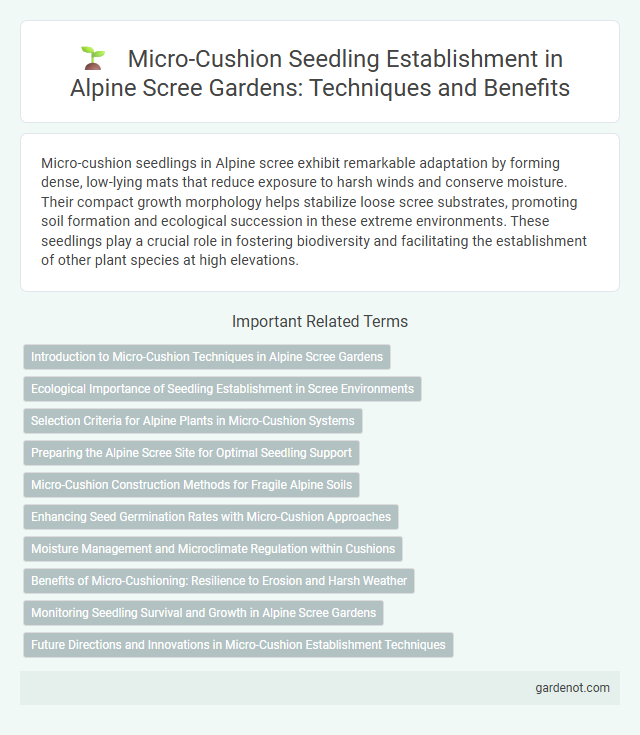Micro-cushion seedlings in Alpine scree exhibit remarkable adaptation by forming dense, low-lying mats that reduce exposure to harsh winds and conserve moisture. Their compact growth morphology helps stabilize loose scree substrates, promoting soil formation and ecological succession in these extreme environments. These seedlings play a crucial role in fostering biodiversity and facilitating the establishment of other plant species at high elevations.
Introduction to Micro-Cushion Techniques in Alpine Scree Gardens
Micro-cushion techniques in alpine scree gardens involve cultivating dense, low-growing plant clusters that mimic natural cushion plants to enhance survival in harsh, rocky environments. This method improves water retention and protects seedlings from extreme temperature fluctuations, facilitating better root establishment on unstable scree slopes. Utilizing these micro-cushions promotes biodiversity by supporting specialized alpine flora adapted to high-altitude conditions.
Ecological Importance of Seedling Establishment in Scree Environments
Micro-cushion seedlings play a critical role in stabilizing alpine scree by anchoring loose substrate, reducing erosion, and creating microhabitats that facilitate colonization by other plant species. Their dense, cushion-like growth form improves soil moisture retention and buffers temperature extremes, which are vital for seedling survival in harsh scree environments. This establishment process underpins biodiversity maintenance and ecosystem resilience in alpine landscapes.
Selection Criteria for Alpine Plants in Micro-Cushion Systems
Micro-cushion seedlings thrive in alpine scree environments due to their compact form, which minimizes water loss and withstands harsh winds. Selection criteria for alpine plants in micro-cushion systems prioritize traits such as low stature, dense leaf arrangements, and high root-to-shoot ratios to enhance survival in nutrient-poor, well-drained substrates. Species like Androsace and Silene exemplify these adaptations, offering resilience and stability in microhabitats prone to temperature extremes and limited soil moisture.
Preparing the Alpine Scree Site for Optimal Seedling Support
Preparing the Alpine scree site for Micro-cushion seedling support involves thorough assessment of micro-topography and soil drainage to mimic natural habitat conditions. Stabilizing loose scree with biodegradable mesh and incorporating organic matter enhances moisture retention, crucial for seedling establishment. Selecting sites with minimal frost heave and adequate sun exposure ensures optimal growth and resilience of Micro-cushion plants.
Micro-Cushion Construction Methods for Fragile Alpine Soils
Micro-cushion construction methods enhance seedling survival in fragile alpine scree habitats by stabilizing unstable soil surfaces and reducing erosion. Techniques involve layering organic materials such as moss and lichen fragments to create a protective microhabitat that retains moisture and buffers temperature fluctuations. These methods promote root establishment and improve microclimate conditions critical for the growth of slow-developing alpine seedlings.
Enhancing Seed Germination Rates with Micro-Cushion Approaches
Micro-cushion seedlings significantly enhance seed germination rates in alpine scree environments by providing stable microhabitats that retain moisture and protect seeds from harsh temperature fluctuations. The dense, cushion-like structure reduces wind desiccation and soil erosion, creating optimal conditions for seedling establishment. Studies show germination success increases by up to 40% when seeds are sown within micro-cushion formations compared to exposed scree surfaces.
Moisture Management and Microclimate Regulation within Cushions
Micro-cushion seedlings in alpine scree environments exhibit exceptional moisture management by trapping dew and reducing evapotranspiration through dense, compact structures. These cushions create stable microclimates that buffer temperature fluctuations and retain humidity, essential for seedling survival in harsh alpine conditions. Their unique morphology promotes sustained hydration and thermal regulation, enabling growth in otherwise arid and unstable scree substrates.
Benefits of Micro-Cushioning: Resilience to Erosion and Harsh Weather
Micro-cushion seedlings exhibit exceptional resilience to erosion and harsh weather due to their dense, compact growth form that stabilizes soil in alpine scree environments. Their tightly packed leaves reduce wind impact and retain moisture, enhancing survival in extreme temperature fluctuations and nutrient-poor substrates. This adaptation not only secures the seedling's root system but also promotes long-term ecosystem stability on fragile scree slopes.
Monitoring Seedling Survival and Growth in Alpine Scree Gardens
Micro-cushion seedlings in alpine scree gardens require precise monitoring to assess survival rates amid harsh environmental conditions such as temperature fluctuations and limited soil nutrients. Regular data collection on seedling height, root development, and leaf density provides critical insights into growth patterns and stress responses. Employing standardized measurement protocols enhances the accuracy of long-term ecological studies within these fragile mountain ecosystems.
Future Directions and Innovations in Micro-Cushion Establishment Techniques
Advancements in micro-cushion seedling establishment focus on enhancing substrate formulations and optimizing moisture retention to improve survival rates in alpine scree environments. Emerging techniques incorporate biodegradable hydrogels and mycorrhizal inoculants to promote root development and stress tolerance under extreme conditions. Integration of remote sensing technology for site-specific microclimate monitoring guides precise seedling placement, boosting restoration success in fragile alpine ecosystems.
Micro-cushion seedling Infographic

 gardenot.com
gardenot.com